#i'm an amateur my information is surface level here
Explore tagged Tumblr posts
Text
So, remember a few posts ago when I made up a game to go outside and identify every tree I see, but I had to give it up because it's February? And nothing has leaves? I remembered later this doesn't apply to evergreens! Evergreens are still out there, and actually much more easy to point out, now that everything else is bare.
So. This is the knowledge I gathered from various sources from the internet!
Pines have long needles and they grow together in bunches, their silhouette is rounded at the edges, distinct and easy to recognize.
Spruce's branches are always pointed up, and grow upwards. Their needles grow in all directions out of the branches. Their needles also have 4 sides to them, and are easy to roll between fingers.
Fir's needles grow only to the left and right, and leave the middle of the branch exposed. The back of the needles have 2 white lines. Their lower branches point down.
Yew's needles are soft to touch, their color is more vibrant than the other evergreens, they grow red berries on them. Their needles also only grow from the sides, and not in the middle. Yew is the poisonous one that must not be mistaken for the rest!
With this info in my mind, I set off! This is the first evergreen tree I found, right in front of the building. I never tried to figure out what it was before.
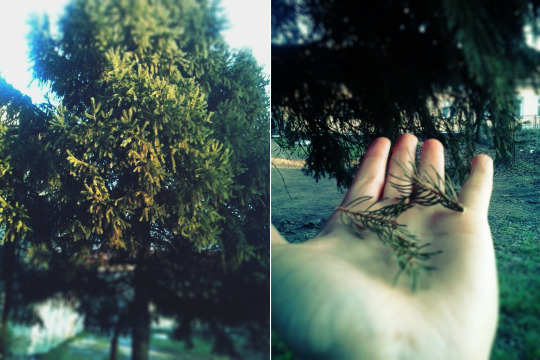
It looks majestic. What I can see here, is needles growing in every direction from the little tip I took off, so I decided it has to be spruce.
The next tree I noticed was in someone's backyard, but I wouldn't let that deter me! It was big and noticeable from far away! So. I sneaked in to take a picture:

Isn't it beautiful? This one also has needles growing from all directions, so it has to be another spruce. But, this one also has some tiny cones growing? I noted that as interesting, and moved on to the next.
Then I saw these two in people's backyard:
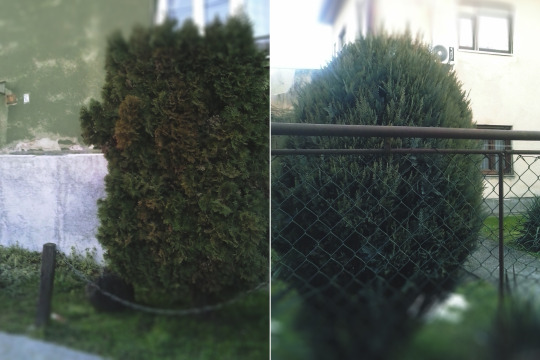
And I thought, well what are these? At first I thought, cypress, but these are obviously two different things, and they seem to be bushes at that, and I didn't research any bush varieties, so I had to let that go for now. If anyone can tell me their names I would love that!
And then I found lots more of similar trees!
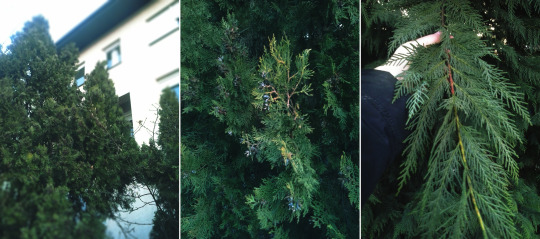
They were definitely planted for decoration, and they're planted all together, but some of them have kind of a purple berry (cone?) growing on them, while some don't, and I'm not sure if they're the same species. Though I do think sometimes trees will grow their fruit only from the side that is more exposed to the sun, so it's possible the branches without berries are just underexposed to the light.
So the next several trees I found were spruces, or so it seems. I'm starting to get suspicious, because first, why didn't I know we were in a spruce-supremacy biome, second, why do all of these trees look so different? Look at them:
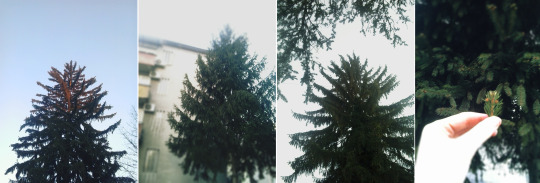
Look how janky some of them look! That is fun! Is that really a spruce? They all had needles growing in all directions, and the tips of their branches pointing up, but I'm starting to get suspicious and feel like these are different varieties of trees and we just called them all 'spruce' and moved on.
Then I, on purpose, went to the place with pines, where I usually harvest my pine needles for tea. This is, one of the most beautiful pines in the city:
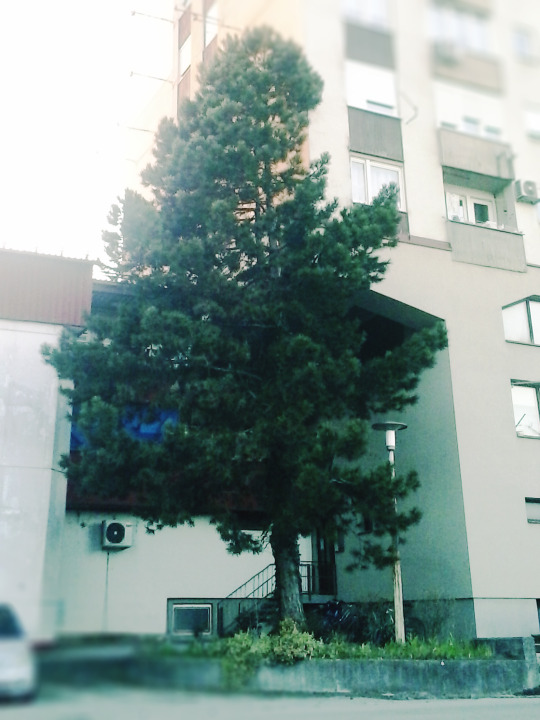
This is not even a good picture of her, this being is divine. She's about the only thing that makes this place livable, every time I see her I'm astounded and filled with awe, she's so gorgeous and lush and perfect? Her shape? The feeling of being closer to heaven when you look at her? She has it all. I don't even know how they made that gorgeous tree grow next to such an ugly building. Anyway.
Close by is a little park made out of pine trees, I was able to find a little pine cone! And here are the pine needles:
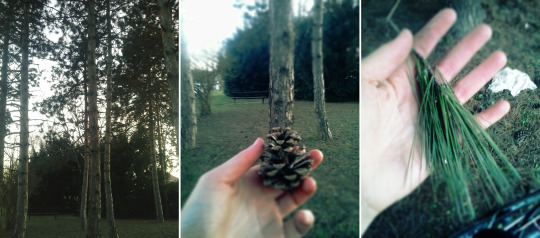
These can be eaten, added into meals, they can be made into syrups, tinctures, and they make a very calming tea! You can also weave a basket with them, which I did once! Blessed source of life.
Spruce and Fir needles are also edible and medicinal, but I've never tried them, so I'm not gonna talk about that yet. But here's whats NOT edible. The deadly yew tree:
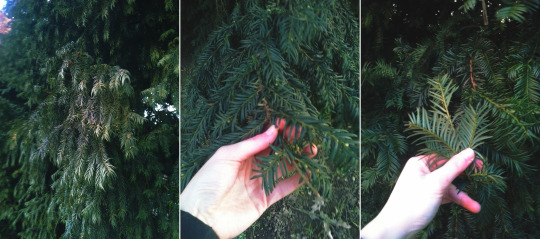
She's so soft to touch, it's almost impossible not to recognize. If you touch an evergreen and it's super soft and pliable, do not eat it! She's also beautiful and vibrant with her colors, I took pictures of this tree before, just because it was so pretty. You can see the needles also grow only on the sides, and not in every direction like the spruce.
And then, I noticed this tree from the road, and it was Different from all of the others. Firstly, it was growing new shoots, which most of the others were not into. Second, it looked super lush and healthy. I couldn't back out further to take a better picture because of the cars behind me, but I grabbed a little shoot, and checked it.
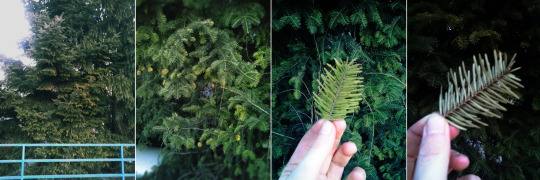
And see these needles how they're only growing to the sides, and not from the middle? And when you turn the needles on the other side, I know you can't see it, but there were 2 white lines on them! I've found a Fir!
That was the first, and the only fir I've found. I was so happy, relieved, and thrilled to find, all 4 evergreen species in walking distance of my residence. I also was pleased to know that my methods of recognition were true, firs really do have white lines on the underside of needles. Who knew!
Now, these are not all of the trees I've found, but the rest I found only gave me more questions than answers. I've found some baby spruces that looked completely different, like this:
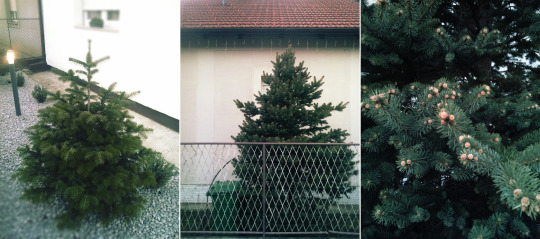
And while I do find these adorable, I wanna know why are they so different? Is it because they're tiny? They look more lush and healthy, is it because they're cared for or they're different, imported species? Why is that last tree in the middle of cone production, while the other spruces are after different businesses? If this is a matter of different varieties then I'm personally offended nobody explained this to me.
Also, I found this bush? And it smelled? Incredible??

The scent of this was thousandfold the power of any other plant. Smelling this transported me into a thousand old forest and underground. After touching this, my entire hand smelled like it for the rest of my trip, I could smell nothing else. It was pine-like but also plant like, and deeper, stronger, like I was smelling not the ends of the plant but the middle of a tree, the center, the roots and the soil. I took a bit of it home to smell. I think it will do me good. Further research revealed that this is a juniper bush, well known for its intense and overpowering scent!
I'm happy to report that this tree ID mission has cured my anxiety for the day, made me feel like a sneaky little secret scientist, gave me special inside knowledge of the evergreen tree society around me and had me meet some awesome trees! I also found some I didn't even know were growing close to me. I looked into making the syrup from the needles, but found out it required outrageous amount of sugar, so I gave up on it. I'm going to use little branches and shoots I took to make tea out of all of the edible plants instead.
#evergreen trees#fir#pine#spruce#yew#tree ID game#juniper bush#don't take this as educational tool#i'm an amateur my information is surface level here#i'm just pointing finger saying Tree!!!#Research on your own!!!!#I will however completely trust my conclusions and drink tea from all of the needles hehehehehe#except yew i dont wanna die#this was such a fun time outside#and i learned a lot#i can't wait to go ID more trees
57 notes
·
View notes
Text
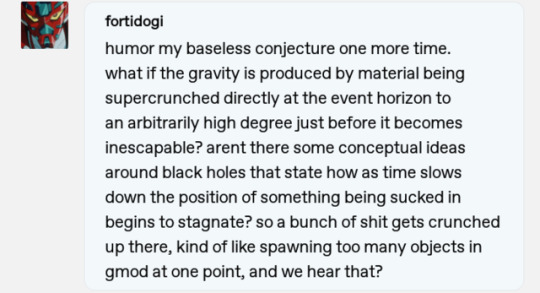
i'm ALWAYS down to humor conjectures on main but as usual i have to say, until i get another degree, i'm not "in the sciences" in any sense, and might not be the best person to ask. my answers could easily be flawed. also this gets LONG so start scrolling now
you're saying all of a black hole's gravity originates from its surface? falling into a black hole is a reenactment of zeno's paradox, where you cross half and half and half a distance and never actually get there? this is a valid idea in fringe science, i think, although i have to admit no one really knows for sure, and least of all me -- but it gets even weirder: mathematically, you can show an equivalence between the surface of a sphere and its interior. they are the same. you can encode all the information that the sphere contains on its surface alone. you can perform calculations on the surface-model, and translate the equation to the sphere-model's math (and the other way around) -- occasionally bringing to light some high-level, previously invisible insights.
this is juan maldacena's ads/cft correspondence, which is probably the most horrendously complicated thing physics has to offer that might actually bear some relation to reality. (string theory and supersymmetry are probably more complicated but also more dubious.) bear with me here -- when i say it bears relation to reality, i don't mean to make a tangible statement about black holes. i mean the math was exceptionally productive, and it took us in exciting new directions.
so, the black hole correspondence would be a 2d surface equivalent to a 3d sphere, but maldacena was actually talking about an equivalence between 11d and 26d, which are crucial numbers of dimensions for some reason in string theory and m theory (the extended, all inclusive version of string theory). this is why people sometimes pretend they're very much in-the-know when they say things like "the universe might be a projection," but i doubt that maldacena is a literalist on this. what i mean is, just because you can express some string theories interchangeably in 11 or 26 dimensions, that doesn't actually lend credence to the universe genuinely being 11 or 26 dimensional or interchangeably both. maldacena's math is not proof the universe is a projection, but it's probably the origin of the idea, and there's a reason it still captivates scientists and amateurs alike (it's from the 80s or 90s).
anyway, i don't know about this as an answer for "why can we detect gravitational information from an object that isn't supposed to let any information escape?" because if the relativistic effects are dilating time such that the matter becomes "frozen" in place "on the surface" before it ever "crosses" the horizon, or whatever, then why can gravity propagate back out, while massless light can't? it's the same problem wearing different pants again. i think it hinges on what you said about becoming supercrunched "just before it becomes inescapable" which, what does that mean? if it's compressed before the point of no return then it could theoretically return.
so either the material falls in and then how does gravity from that matter get back out? or it doesn't fall in and then why doesn't the matter escape again? i think the real answer is "both of these things do happen," which is why we have an accretion disk and relativistic jets outside the horizon, as well as a horizon.
(to put the finest possible point on it, light absolutely can escape a black hole and so can anything else, but only as hawking radiation, which is unconfirmed and unobserved, and is based on quantum fluctuations in the vacuum getting ripped apart by the black hole... to put the finest point on the finest point, vacuum fluctuations just spontaneously appear, so anything that radiates back out in this manner is not technically a thing that ever went in.
could you say "all of a black hole's gravity is hawking radiation"? sure, but then you have to deal with every black hole being much, much, much, much, much, much more massive than what we detect, and you have to deal with this mass just... no longer influencing anything around it, which is, again, sort of the same problem we started with. it might be less abhorrent this way. i have no idea.)
there might be something to the idea "all the effects of gravity are from matter which is frozen in the outer shell, and either we literally have not a single shred of information about what's beyond the horizon or there isn't anything beyond it" but i suspect someone smarter than me is going to have to come along and restate it in a more sensible way, because i'm always going to get distracted by the incredible possibility of the surface and the interior being the same object in superposition.
anyway actual theoretical astronomers are currently discussing something called "the firewall problem" and i have no idea what that really is, or whether it's the same thing i'm talking about here -- so if you want to know what the professionals are up to, they're asking different questions (or at least phrasing them differently). honestly my real-world suspicion is that as soon as i understand enough about black holes, i'll understand why this question was nonsense.
more to the point, perhaps: whether you can grasp the secrets of the universe using only your own mind is also, presently, an open question among professionals. einstein thought it was possible, and lee smolin is carrying that torch to weird and not-mathematically-rigorous places... i'm not sold. i think you can cover a lot of ground, but don't think it's possible to follow your intuition to a realistic theory bridging quantum and relativistic effects on the edge of a black hole. it might be too extreme to grasp without extreme math and theory, instruments, and observations. but again, all of my information comes from verbal descriptions of math, which is a funny sort of game of telephone. (everything i know about juan maldacena is from lisa randall, whose descriptions of the standard model were on point, but whose predictions have been completely invalidated at the energy range CERN has probed. there isn't much human-readable primary source maldacena.)
what i mean is, we can discuss this until we're blue in the face, but until we have a theory that matches observation on the matter, it's... surprise!.. just conjecture. no one can start the next revolution in science without some mathematically rigorous predictions matching observation. the next einstein needs a catchier equation than e=mc^2 in order for it to catch on
2 notes
·
View notes